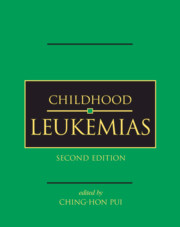Book contents
- Frontmatter
- Contents
- List of contributors
- Preface
- Part I History and general issues
- Part II Cell biology and pathobiology
- Part III Evaluation and treatment
- 14 Pharmacokinetic, pharmacodynamic, and pharmacogenetic considerations
- 15 Assays and molecular determinants of cellular drug resistance
- 16 Acute lymphoblastic leukemia
- 17 Relapsed acute lymphoblastic leukemia
- 18 B-cell acute lymphoblastic leukemia and Burkitt lymphoma
- 19 Acute myeloid leukemia
- 20 Relapsed acute myeloid leukemia
- 21 Myelodysplastic syndrome
- 22 Chronic myeloproliferative disorders
- 23 Hematopoietic stem cell transplantation
- 24 Acute leukemia in countries with limited resources
- 25 Antibody-targeted therapy
- 26 Adoptive cellular immunotherapy
- 27 Gene transfer: methods and applications
- 28 Minimal residual disease
- Part IV Complications and supportive care
- Index
- Plate Section between pages 400 and 401
- References
27 - Gene transfer: methods and applications
from Part III - Evaluation and treatment
Published online by Cambridge University Press: 01 July 2010
- Frontmatter
- Contents
- List of contributors
- Preface
- Part I History and general issues
- Part II Cell biology and pathobiology
- Part III Evaluation and treatment
- 14 Pharmacokinetic, pharmacodynamic, and pharmacogenetic considerations
- 15 Assays and molecular determinants of cellular drug resistance
- 16 Acute lymphoblastic leukemia
- 17 Relapsed acute lymphoblastic leukemia
- 18 B-cell acute lymphoblastic leukemia and Burkitt lymphoma
- 19 Acute myeloid leukemia
- 20 Relapsed acute myeloid leukemia
- 21 Myelodysplastic syndrome
- 22 Chronic myeloproliferative disorders
- 23 Hematopoietic stem cell transplantation
- 24 Acute leukemia in countries with limited resources
- 25 Antibody-targeted therapy
- 26 Adoptive cellular immunotherapy
- 27 Gene transfer: methods and applications
- 28 Minimal residual disease
- Part IV Complications and supportive care
- Index
- Plate Section between pages 400 and 401
- References
Summary
Introduction
The concept of using gene transfer techniques to express a new gene in the somatic cells of a patient has stimulated considerable interest, speculation, and hyperbole. The inevitable backlash against promises that so far have not been fulfilled has led to much confusion about the aims and achievements of gene transfer and to a lurking suspicion that the entire field is simply a South Sea bubble waiting to burst. This chapter seeks to provide a balanced account of the current status of gene transfer as applied to leukemia and related disorders, and to review the accomplishments of the field as well as the impediments to progress. Most importantly, it will try to give an idea of the incremental way in which gene transfer technologies will supplement, long before they supplant, current therapeutic approaches to hematologic malignancies.
There are two broad strategies of gene transfer applicable to the treatment of leukemia and lymphoma. First, the tumor cell itself can be genetically modified to “repair” its intrinsic molecular defect. Alternatively, a toxic gene can be introduced to destroy the tumor cell, or it can be transduced to express molecules that trigger an immune response against it. Second, the host's T cells can be redirected, their antitumor activity augmented, or they can be transduced with suicide genes to terminate potentially harmful immune reactions. The drug sensitivity of normal host tissues can be decreased by delivering cytotoxic drug-resistance genes to sensitive tissues, thereby increasing the therapeutic index of chemotherapy.
- Type
- Chapter
- Information
- Childhood Leukemias , pp. 661 - 678Publisher: Cambridge University PressPrint publication year: 2006



